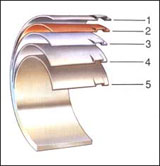
90% White Metal Bearings |
|
|
| Performance
Benefits:
.
Lowers Lub. Oil Consumption
. Maintains
specified fuel Consumption for longer service
. Can
be used against hardened as well as unhardened shaft
. Protects
shaft from extensive damage
|
Special Features:
. Reduces operating cost Considerably.
. Lined with Genuine Tin Base 90% While Metal
. Retains Lubricants
. Embeds dust and debris carried by the Lubricant and prevents scoring at high loads
. Highly compatible to avoid seizure
. Conforms to misperfection in Shaft geometry
. High Strength to resist deformation by both steady & fluctuating loads
. Resists corrosion by lubricants
. Good thermal conductor, dissipates heat faster from the mating surface and runs cool
. Excellent resistance to wear under conditions imposed in journal |
Copper-Lead
Bimetal Bearings & Bushes (CUPB) |
|
|
Copper Powder Metallurgy for Bearings:
. Copper readily
forms a protective oxide film when heated in air.
. Copper readily
forms a protective sulphide film with oils containing only traces
of sulphur compounds.
. Copper has
a high thermal conductivity for the dissipation of the frictional heat,
thus reducing the surface temperature.
. Tin strengthens
copper and hardens it sufficiently to be compatible
with unhardened steel.
. The protective
Organo-tin films formed with oils have a high
desorption temperature
. Hence the
copper-tin bronzes result in better bearings than the
copper-zinc brasses.
. Copper alloys
usually have a face-centered-cubic structure while the
mating surface is usually a ferrous alloy
with a body-centered-cubic structure.
This difference
contributes to the anti-seizure characteristics of copper
alloys
against iron alloys.
Overlay
Plated Copper-Lead Bearings for Heavy Duty Service:
. The Copper-Lead
Bearings when plated have higher load carrying capacity
than straight copper-lead alloys.
. These overlays
are very soft and have excellent embeddability,
conformability and corrosion resistance without impairing
higher fatigue
strength of inner copper-lead-tin alloy.
 |
Different Layers in typical overlay plated bearing
are as under:
. The
steel backing to give the bearing
strength and regidity.
. The
copper-lead-tin intermediate, alloy lining
is permanently bonded to the steel back by
intering process. It is the lining alloy that
will stand up under extreme bearing loads.
. A nickel
plate or nickel barrier - just 2-3
microns thick - preventing the tin
|
from overplate alloy from being
drawn into copper-lead alloy lining.
. The
lead-tin-copper plate that easily confirms to slight
irregularities
in the crankshaft journals during engine run-in.
. The
pure tin flash plate which provides corrosion and rust
resistance all over.
|
|
|
>
Engine Bearing &
Bushes
>
Lubricants
>
Quality
Control
|







